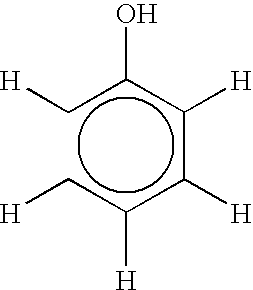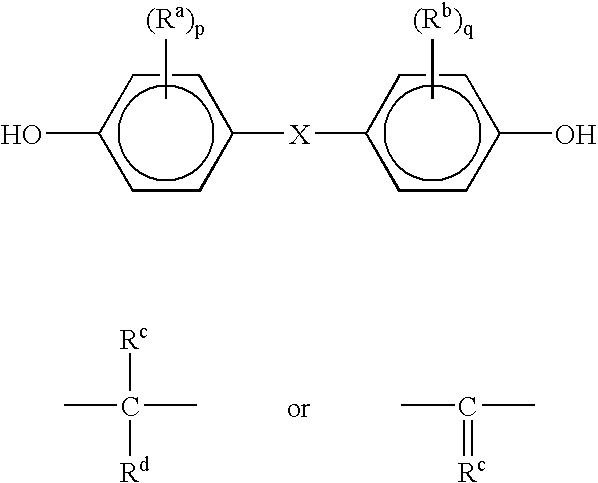The reactor includes a supported catalyst bed through which the reactants flow to catalytically produce the final bisphenol. The flow preferably used is a supported downflow mode in which reactant materials flow co-currently from a higher elevation to a lower elevation through the bed to facilitate the
chemical reaction to produce the bisphenol product. Although the method is applicable to the production of any isomer of bisphenol, the preferred isomer is p,p'-bisphenol A produced by the reaction of phenol with
acetone (dimethyl
ketone) in the presence of an
ion exchange resin catalyst which may optionally be modified by selected promoters such as, for example, mercaptan compounds, if desired. The reactor is shown in FIG. 1 at 10 and includes a bed 14 containing an
ion exchange resin catalyst and randomly dispersed packing. The bed receives co-current downflow streams of the reactants. The
ion exchange resin catalyst is distributed around the packing so that the catalyst is supported within the bed to minimize channeling and compressive forces, as well as to optimize the hydraulic performance of the reactor. Any type of reactor vessel used to react reactants in the presence of fixed catalyst is generally amenable to practicing this invention. However, cylindrical reactors are preferred for their simplicity.
The random arrangement of the packing in the shell provides support for the resin catalyst and minimizes compression. "
Settling" of the catalyst is essential and desirable to insure complete filling of the void spaces within the catalyst bed. The packing also ensures that the cumulative compressive forces (which are the sum of the forces created by gravity and the viscous drag from the downflow of reactants) are interrupted to such a degree that high conversion,
high selectivity, and long lifetime can be realized by the resin catalyst. The minimization of the compressive forces is enough that the "wall effects" of the packing elements are spread through the bed on a
microscopic scale.
This type of
inert random packing interrupts the packing structure of the spherical resin particles to provide a larger effective void fraction. The resin bed alone usually has a void fraction of about 0.36 and small increases in this is expected to result in dramatic decrease in pressure drop. Although
decreased pressure drop caused by increased void fraction is less desirable than that caused by preventing compression, since the increased void fraction represents paths for "channeling" or "short circuiting", which reduces the
contact time of the reactants and catalyst. Increasing the void fraction within the catalyst is less desirable than simply preventing the decrease of void fraction caused by bead deformation.
Preferably, the packing comprises metallic
cascade rings, such as
CASCADE MINI-RINGS.RTM. available from Koch-Glitsch, Inc., Wichita, Kans. This
cascade ring has a void fraction of about 0.97. Other objects that may be utilized include typical
tower packing elements such as Pall rings, Tellerette rings, Raschig rings, Berl saddles, Intalox saddles, as well as combinations of these as desired. Examples of some of these are disclosed in U.S. Pat. No. 4,041,113 and 4,086,307. In addition to better hydraulic characteristics, the preferred metallic
cascade ring packing material improves the temperature differential in the reactor. This can be used to run the same
inlet temperature to give a lower outlet temperature or to run at a higher
inlet temperature to get more production at the same purity. Further, the temperature differential between the inlet and the outlet of the reactor packed with these elements will be less than the temperature differential between the inlet and the outlet of an unpacked reactor while conversion of reactants in each reactor is substantially equal.
Acidic
ion exchange resin is also used in the
alkylation of
phenols (U.S. Pat. No. 4,470,809). In the presence of a cation-exchange resin catalysts, alphamethyl
styrene reacts with phenol to form paracumyl phenol (U.S. Pat. No. 5,185,475); and
mesityl oxide reacts with phenol to form Chroman. On use, the individual particles of the resin catalyst are subject to compressive forces due to hydraulic loading; at lower levels of crosslinking the particles are less rigid and more susceptible to hydraulic deformation. The degree of crosslinking of the
ion exchange resin catalyst can be up to about 4% but is more preferably up to about 2% to improve catalyst life.
The method for production of bisphenol A from phenol and acetone includes introducing the phenol and the acetone into the
ion exchange resin catalyst bed to react the phenol and the acetone in the presence of the resin catalyst and then recovering the bisphenol A from the reaction mixture. The introduction of the phenol and the acetone is at the upper end of the bed (to facilitate the co-current downward flow of the reactants) at a rate sufficient to allow the reaction to proceed to a pre-determined yield and selectivity. The reaction of phenol and acetone is ordinarily carried out at a temperature sufficient so that the feed of the reactor remains liquid and preferably at a temperature of about 55.degree. C. or higher. Also preferably the temperature is less than or equal to about 110.degree. C. and preferably less than or equal to about 90.degree. C. The introduction of the reactants is generally at a weighted hourly
space velocity (WHSV) of greater than or equal to about 0.1 pound of feed per hour per pound of dry catalyst (lbs. feed / hr. / lbs. catalyst) and preferably greater than or equal to about 1.0 lb. feed / hr. / lbs. catalyst. Also preferred is less than or equal to about 20 lbs. feed / hr. / lbs. catalyst and preferably less than or equal to about 2.0 lbs. feed / hr. / lbs. catalyst. The introduction of the reactants is also generally at a flux rate of greater than or equal to about 0.1 gallon per minute per
square foot of cross section of bed (gpm / ft.sup.2) preferably greater than or equal to about 0.5 gpm / ft.sup.2 Also preferred is an amount of less than or equal to about 2.0 gpm / ft.sup.2 and most preferred is less than or equal to about 0.5 gpm / ft.sup.2. The temperature of the reaction can be controlled in part by the flow of the cooling
stream through the jacket to remove the heat of reaction. However, in a plug flow
packed bed, radial
heat transfer is low, so that the reactor functions mostly adiabatically. Packing can help improve
heat transfer and thus reduce adiabaticity, improving
temperature control. The temperature of the reaction can be up to about 110.degree. C., but is preferably limited to about 85.degree. C. During
steady state operation of the reactor, the
differential pressure between the inlet and the outlet 24 is greater than or equal to about 0.1 pound per square inch gauge (psig) preferably greater than or equal to about 3 psig. Also preferred is less than or equal to about 30 psig and more preferred is less than or equal to about 24 psig.
 Login to View More
Login to View More 


